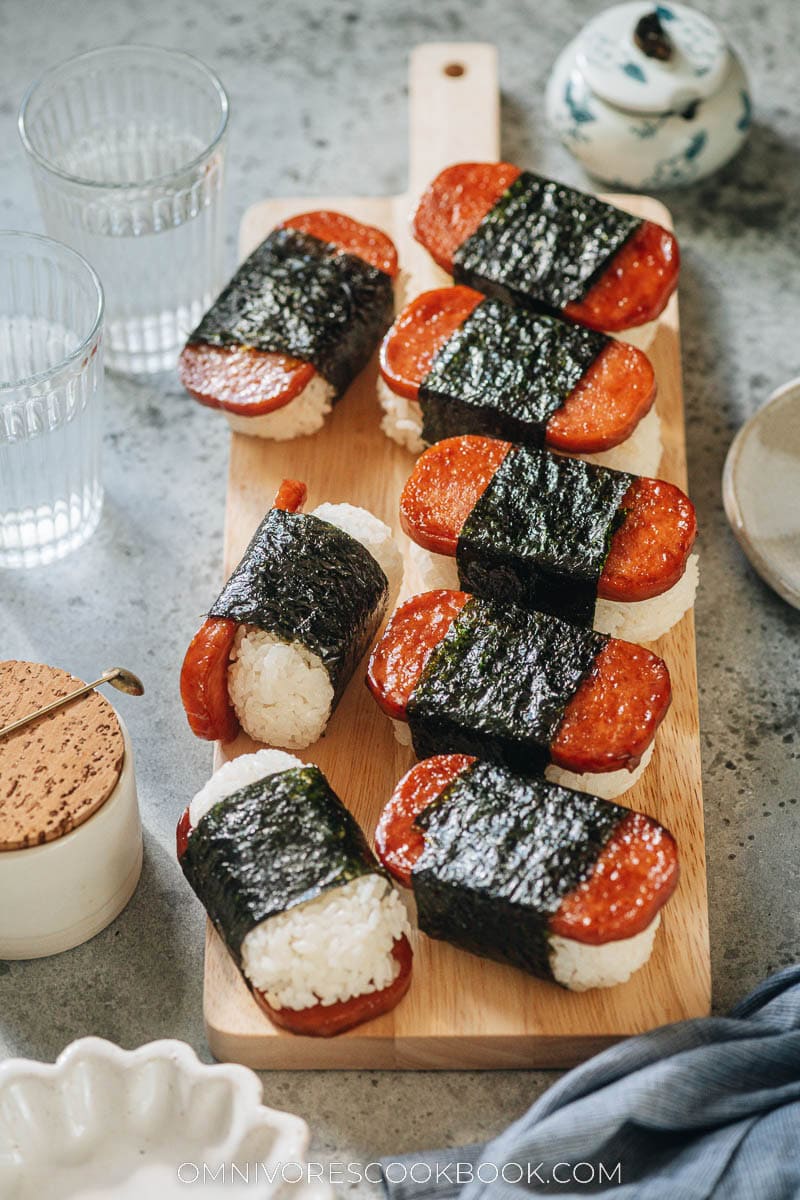
Spam & Chinese cooking
The word Spam might make you think of high-sodium military rations. But in China, Spam is a popular ingredient that people use in comfort food. Spam and pepper stir fry, Spam omelet, Spam ramen, Spam fried rice, or Spam sandwich. You name it.
Spam is also a common ingredient in Chinese Hot Pot and Sichuan Mala Dry Pot – a popular type of Chinese restaurant where you choose a spicy sauce and various ingredients that are cooked in it and then everything is served in a big pot. Every time I go to Mala Pot restaurants with friends, I remember to order a few slices of Spam and it’s always the most popular ingredient in the pot.
Spam is so intertwined with Chinese food culture that I’d never considered Spam a foreign food until I moved the US. Then I started to wonder when it came to China.
After some digging, I found out the following. According to Wikipedia:
“In China, Hormel decided to adopt a different strategy to market Spam, promoting it as a foreign, premium food product and changing the Spam formula to be meatier in order to accommodate local Chinese tastes.”
Apparently, Hormel also decided to name it “luncheon meat” (午餐肉) instead of Spam, to make it sound glamorous. No wonder. Back in old days, Spam was considered a fancy thing that people would serve for dinner on Chinese New Year.
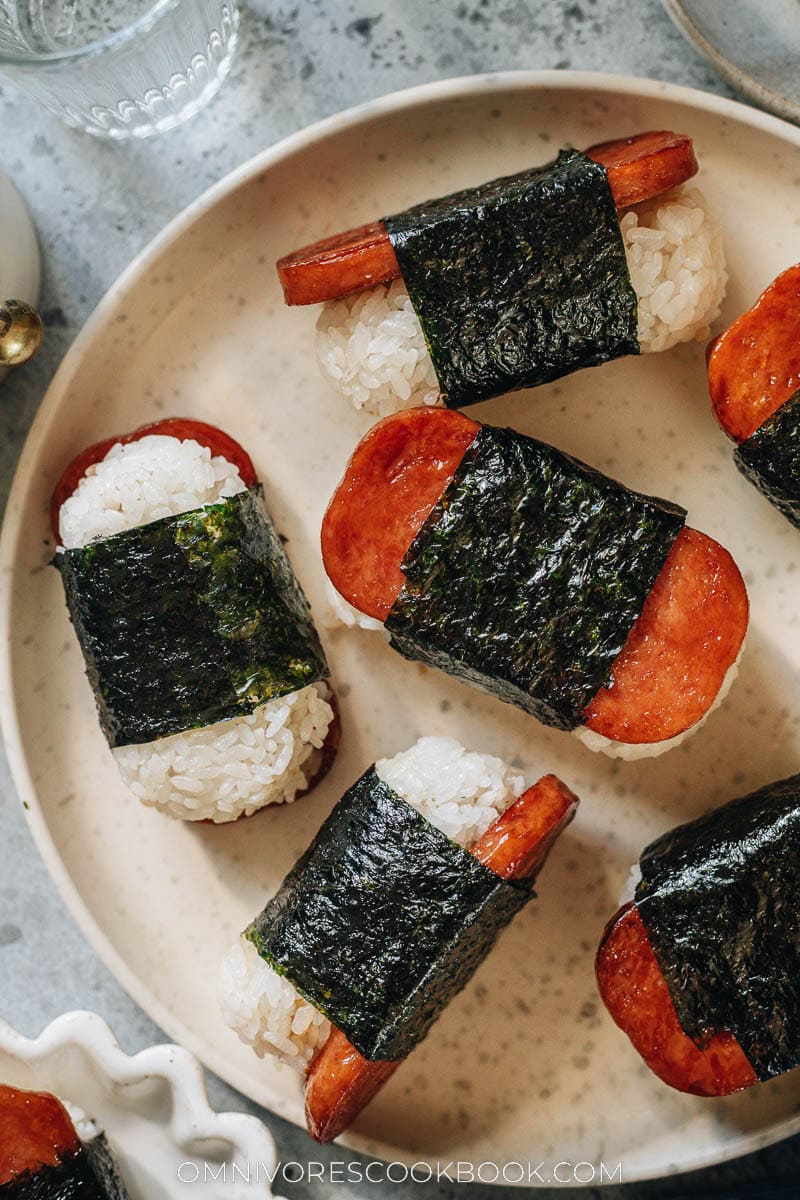
A Common Table Cookbook
This spam musubi recipe is slightly adapted from one in the cookbook A Common Table – 80 Recipes and Stories from My Shared Culture, written by my friend Cynthia Chen McTernan, who is the author behind the award-winning blog Two Red Bowls.
I decided to share her Spam Musubi recipe – a great representation of how Asian food inspired local cuisine and became a part of its culture. Even though I got to know this Hawaiian dish only after moving to the US, it makes me feel nostalgic because of the use of Spam, an ingredient that reminds me of time spent with family and friends.

Spam musubi Ingredients
You only need a few very simple ingredients to make spam musubi:
- Cooked rice
- Spam (I prefer the low sodium type)
- Strips of crispy seaweed (nori)
- Soy sauce and sugar for seasoning
Experiment with sushi rice
The original Hawaiian spam musubi does not use sushi rice, which has added rice vinegar and sugar. But when I make my own spam musubi, I always use sushi rice. The refreshing acidic note cuts the greasiness of the Spam, mellows its saltiness, and works perfectly with the sweet taste.
If you’re feeling adventurous, use the sushi rice recipe from Just One Cookbook. The extra 5 minutes is definitely worth it. Her recipe includes a rice cooker version. Check out this post if you need a detailed instruction on how to make rice on the stovetop.
Seaweed (nori)
Make sure you get the large nori sheet that is about 8” (20 cm) to 9” (22 cm) long. It is usually labeled as sushi nori, yaki nori (roasted seaweed), or laver for Gimbap (if you visit a Korean store). They usually come in large, thin, square packages. And you will need to cut them into strips for this recipe.
How to make spam musubi
Cook the Spam
- Brown the spam until crispy
- Braise the spam with sugar and soy sauce, until the surface is caramelized
It’s very important that you brown the spam slowly and thoroughly. It renders some fat and makes a very crispy crust. Then you will use some sugar and soy sauce mixed with water to quickly braise the Spam. You will end up with a beautifully caramelized dark brown surface that is still chewy and sticky. It’s perfect.

Wrapping the spam musubi
- Place a strip of nori sheet on your working surface, then place the spam at the very end
- Make a ball of rice by pressing it together, then shape it into an oval shape that is similar to the sliced spam
- Roll up the spam and rice using the nori strip
- Make sure to tuck the rice tight enough so the musubi doesn’t fall apart, but not too tight that you tear the nori sheet
- Smear the end of the nori sheet with a bit of water and roll up the musubi, so the nori will stay put.
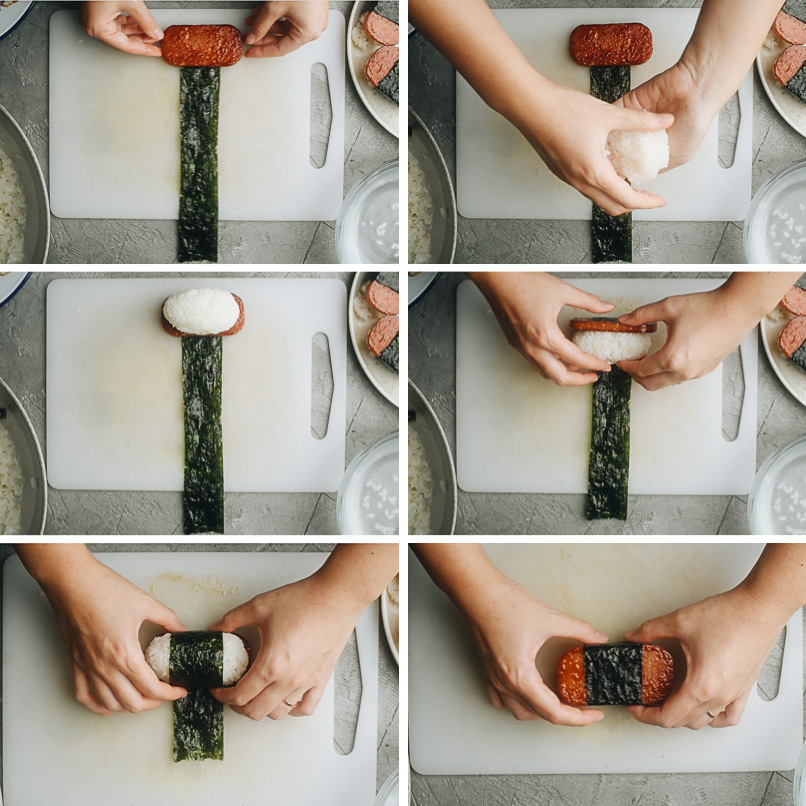
Tips on shaping the rice
You can use a musubi mold to make the rice pressing process much easier and less messy. I only included the traditional way in the recipe, where you use your hands to press the rice. If you like to DIY, you can even use a Spam can to make your own musubi mold (you need to remove the bottom of the can and cut the can a bit shorter).
To make sure the rice doesn’t stick to your hands too much, make sure to always wet your hands before rolling each musubi.
When you press the rice by hand, it’s important to use proper strength so that the rice is pressed together but not overly mashed. If you don’t press enough, the musubi might fall apart when you bite into it. If you press too hard, the rice texture will be too dense. It takes a bit of practice but once you make a few musubi, you’ll get the idea.
How to store and reheat spam musubi
Spam musubi will taste the best when it’s freshly made and you can appreciate the crunchy spam, tender rice, and crispy seaweed. If you serve it within a couple of hours, it’s OK to store them in a container at room temperature. For longer storage, you need to store them in the fridge. If you store them in the fridge, you should always reheat the musubi in a microwave to warm up the rice, to avoid a tough texture.
I’ve not tried freezing spam musubi, but I think it’s totally OK. You should thaw the frozen musubi in the fridge completely, and reheat them before eating.
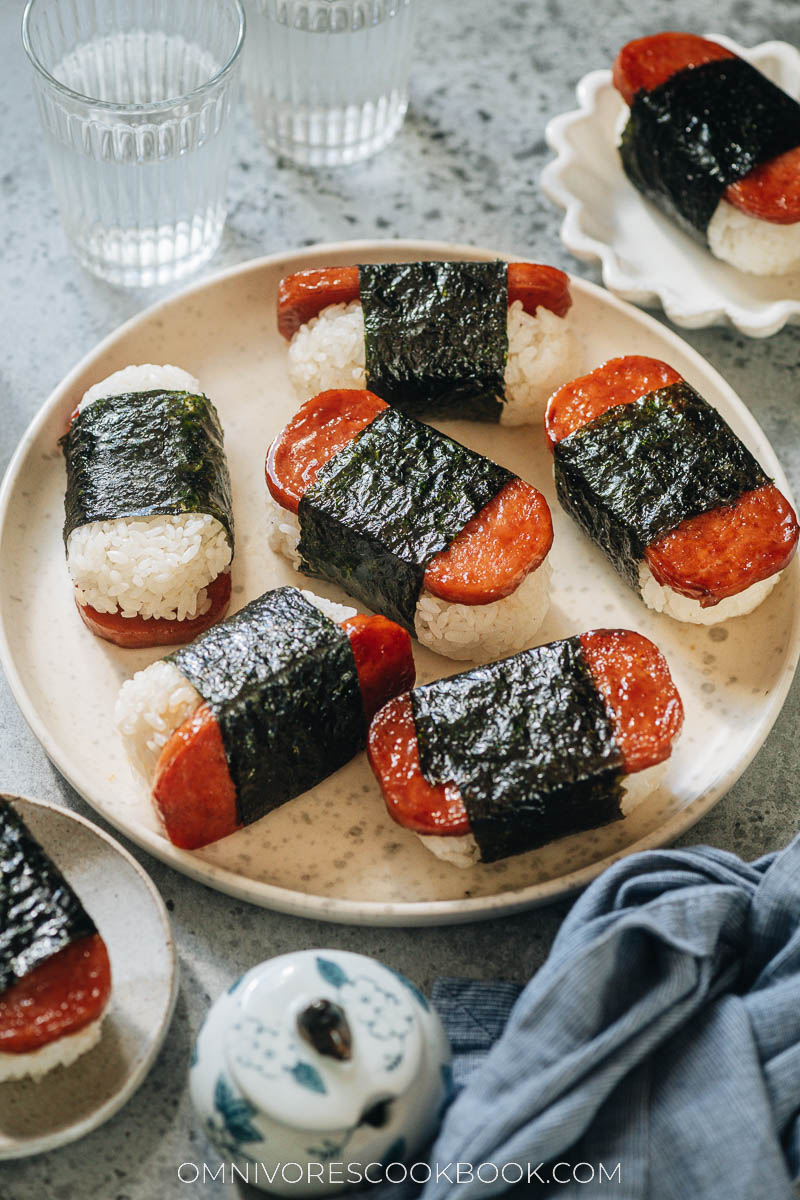
More delicious recipes for your next party
- Air Fryer Chinese Chicken Wings
- Curry Egg Salad Wonton Cups
- Pork Lettuce Wrap (San Choy Bow)
- Old-Beijing Fried Carrot Fritters (炸素丸子)
- Chinese Fried Stuffed Eggplant (炸茄盒, Zha Qie He)
This spam musubi recipe is slightly adapted from the cookbook A Common Table – 80 Recipes and Stories from My Shared Culture, written by my friend Cynthia Chen McTernan
Chinese Cooking Made Easy
Are you new to this website? This free email series is a great place to start. I’ll walk you through a few of my most popular recipes and show you how and why they work. You’ll quickly start to cook better Chinese food in your own kitchen.
Watch video
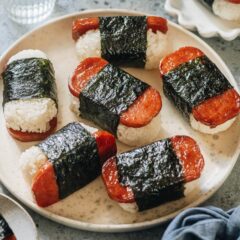
Barter-Worthy Spam Musubi
Ingredients
- 1 teaspoon vegetable oil
- 1 can low-sodium Spam (12 oz. / 340 g can) , sliced into 8 pieces
- 1/4 cup water
- 2 teaspoons soy sauce
- 2 tablespoons sugar
- 4 cups cooked sushi rice (or regular cooked short grain white rice) (*Footnote)
- 3 sheets roasted seaweed (nori) , cut into 8 strips about 2” (5 cm) wide and 9” (23 cm) long
Instructions
- Start making steamed rice (or sushi rice) if you don’t have any already made.
- Heat the oil in a 12-inch (30cm) nonstick or well-seasoned cast-iron skillet over medium heat. Add the Spam slices and cook until browned and crispy on the bottom side, 2 to 3 minutes. Flip and cook until the other side is also browned and crispy, 2 to 3 minutes.
- Whisk together the water and soy sauce in a small bowl. Sprinkle the sugar evenly over the Spam slices, then add the soy sauce mixture. Swirl to evenly distribute, then let the Spam simmer until the liquid is nearly absorbed, 3 to 4 minutes. Flip once in between, so the sugar will melt completely and camalize well. Transfer the Spam slices to a plate to cool.
- To make the sushi: Place one slice of Spam perpendicular to the nori strip on the bottom of the strip (forming a cross shape). Wet the palms and fingers of both of your hands, measure 1/2 cup of rice, and transfer the rice to your palm. Use both hands to firmly press the rice into a ball. Then hold the rice ball with your left hand, with your thumb and the other four fingers to secure both sides, use your right hand to gently press the rice ball into a rectangular shape about the size of the Spam slice. Place the rice on top of the Spam. Roll up the Spam and rice so that the nori sheet wraps around it. Seal the end with a bit of water and place the musubi seam-side-down while you work on the rest. Repeat with the remaining nori strips, Spam slices, and rice. Remember to rinse your hands every time, to minimize rice sticking to your hands.
- Enjoy the spam musubi immediately at room temperature. You can store them in an airtight container or wrap them with plastic wrap and place them in the fridge. To serve refrigerated musubi, warm them in the microwave for 20 seconds or so, to get the best texture.
Notes
- A couple of notes on the rice:
When making sushi rice, always use short grain rice. Medium and long grain rice are less starchy and don’t hold together well when pressed into sushi or musubi.
The original recipe uses regular steamed rice, and so do most Hawaiian Spam musubi recipes.
However, I personally prefer making sushi rice, which contains rice vinegar and sugar. The acid and mild sweetness of the sushi rice complement the salty Spam and create more depth of flavor.
You will use about 3 1/2 cup to 4 cups of cooked rice for this recipe. I found my personal favorite ratio is: slice the Spam into 8 slices, and use 1/2 cup of cooked rice per musubi. In my case, I used 4 cups of cooked sushi rice, which were yielded from 2 rice-cooker cups (180ml per cup) of raw short grain rice.
Nutrition

Did you make this recipe?
I’d love to hear how it turned out for you! Please take a moment to leave a 5-star rating ⭐️ and share your thoughts in the comments further down the page. It really helps others discover the recipe too.

Laura M
I love your blog and now need to start reading your husband’s blog. Spam musubi is a favorite, but my all-time favorite Chinese dishes are soy sauce chicken and beef chow foon, both with a side of gai lan. Thanks for the giveaway.
Gabrielle Rucker
I lived in Dhanghai for 4 months and enjoyed so much great food. But my two ultimate meals are spicy red chilly noodles with handmade wide noodles and any street food. I ate a ton of bao especially the Egg Custard Steamed Buns. When I traveled to kashgar I had grilled lamb, rice pilaf and nan for the first time and fell utterly in love. I miss being there so much and your website keeps me as close as I can be for now.
Elizabeth Ring
Interesting information about Spam. It has a very mixed reputation here. I think my favorite thing about Chinese food is the vegetables and the way they are cooked quickly to a genuine crisp tender and then seasoned perfectly.
Grace
I’m sooooo glad I found your book! I’ve been missing my parent’s home (asian) cooking since I’ve moved out and your book is literally what I needed. Authentic chinese cooking 🙂
Yolanda
Loved hearing the history of Spam in Chinese culture. My favourite Asian dishes are Pad Thai, Pad see Ew, Okonomiyaki, satay, coconut rice and San choy bau. Delicious!
Brenda Louie
I almost fell over when I saw that Maggie included a Musubi recipe in her last posting. My husband and I just came back from a 3 week cycling trip to Big Island Hawaii. All the grocery stores we stop in sold these amazing Musubi snacks to purchase on the go. Oh my god, that’s the replacement for gluten filled bread sandwiches! I bought Musubi cookbooks and musubi molds for Xmas presents for my relatives who have to make lunches for kids everyday. Maggie Zhus Omnivore Cookbook and website was a phenomenal resource discovery for Chinese Canadians like me, who were born in Canada but fully know the great foods made by parents, grandparents, and aunties, who are sadly all gone. If I win a cookbook, I will enjoy it and share it with others who have the same love of cooking. Thank you for the constant inspiration, Maggie.
MAC
I traveled many times to Asia and one of the things I enjoy the most is the cooking and foreign tastes. Sometimes, it is challenging to my North American palate but most of the time, I truly enjoy discovering the cuisine and new ingredients.
Rachel Belanger
This recipe looks interesting and I’m curious about the book! My favourite will always be Ma Po tofu.
Estella McCall
Maggie, I so love your blog. Can you give us a recipe for a dish I had in Shondong Province. It’s like donuts with a wonderful dipping sauce. And there was another one made with pumpkin that comes with a sticky sauce on it. You dip it in water before eating it to stop the sugar strings. If you don’t eat it fast it sticks together in one big clump. And another one I can’t seem to make is an eggplant dish that looks like French fries and has a slight spicy aNd sweet taste to it.
These are some of my favorites. Of course Jiao Zhi is my favorite.
Jennifer Smietana
My favorite Chinese recipes are stews, both wet and dry, that aren’t served in most U.S. restaurants.
Sherry Van Rijn
My grandmother’s tomato beef chow yuk is my family’s fav. We also love cha siu bao, spicy wontons, soy sauce noodles, and tomatoes & eggs. Thanks so much for this giveaway opportunity!
Karen
I love making pot stickers, barbeque pork and roast pork. While some may find making pot stickers from scratch time consuming, I find it very relaxing. And making my own bbq pork and roast pork means I always have them available when I want, instead of needing to head to Chinatown to make a purchase.
Sophie Tang
My all time favourite chinese dish is based around holidays as it is the only time everyone in my family gathers to eat my grandma’s home cooked meal. These include childhood favorites like “ketchup” pasta, lo bak gao, soy sauce fried noodles, chinese style curries, noodle soups and her famous nian gao!
Nina Capaccio
This is so wonderful-total comfort food. Won’t mention my age 😉 , but Dad in army, stationed in Hawaii & learned about Spam and Chinese cooking. He’s Polish/Swedish …:-) Talk about blending cultures. Brought home to Colorado and my Russian mom… was new found food happiness. Been loving spam for generations. This was all during 1950’s when he was in army. Now my hubby and I enjoy at home in Nevada . Egg Works restaurant here serves Loco Moco with Spam…. outstanding., which we also make at home.
Thank you so much for sharing this new and delightful recipe. The soy sauce and sugar with fried spam is simply genius. Musubi will most definitely be on our Chinese New Year menu… talk about good Feng Shui. Think I might add some Bok Choy sautéed or Kimchi.
Carli Lewis
I love Omnivores cookbook and my heart is filled with joy each time I see a new one in my inbox. Believe it or not, my favorite asian dish is simply tea eggs. They are so delightful and a wonderful addition to any meal, any day. I also love simple vegetable dishes such as garlic broccoli or carrot salad. Of course, I have to give a shout out to the Wonderful spice combinations to various meats.
Heim
One of my favs is …..Mapo tofu!
May
I love simple foods like steamed eggs, chow mein and fried rice. I just like food!
There’s a restaurant in Garden Grove, CA, King Harbor Seafood, that serves Lobster With Yee Mein Noodles. It is soooo delicous!
It’s always a treat to have this dish whenever we’re in the area.
Thanks for the opportunity to win a cookbook!
Lin
I love Sichuan Boiled Fish (nice and spicy!), salt/pepper tofu, poached whole chicken with ginger dipping sauce and any kind of stir fried greens for favorite Chinese/Asian foods.
Kenneth Soh
Spam brings back memories of all the great dishes my late grandmother could make from it! Omelettes, fritters, stews, you name it she’s done it!
I think my all time favourite Chinese dish to eat is dumplings with spicy chilli oil & black vinegar. To be honest, I love food so much, it’s pretty impossible to just name my all time fav! Asian/Chinese foods all the way!
Kelley
Anything dumpling… HK style pan fried noodles, my husband loves steamed whole fish and eggs w/tomatoes. And since it’s open to all Asian… LUMPIA!